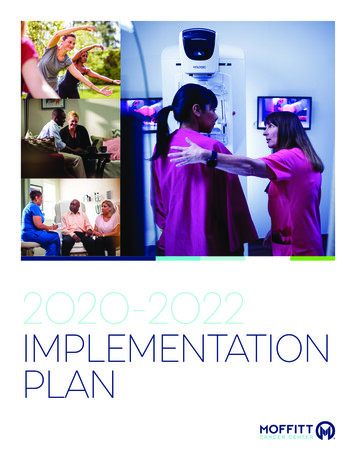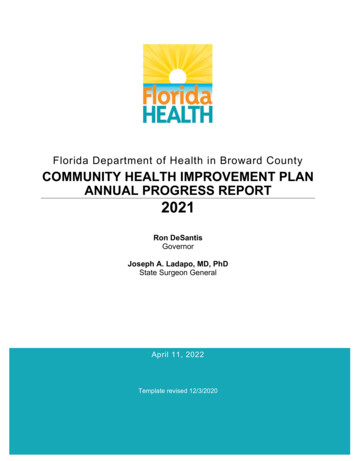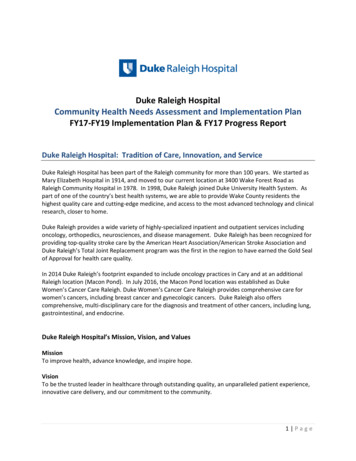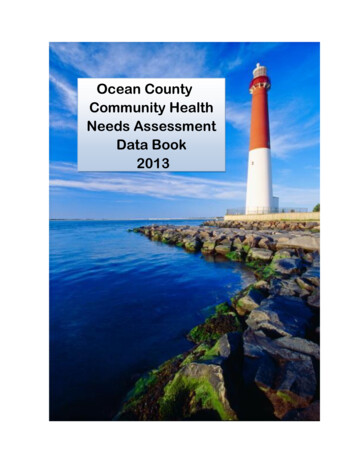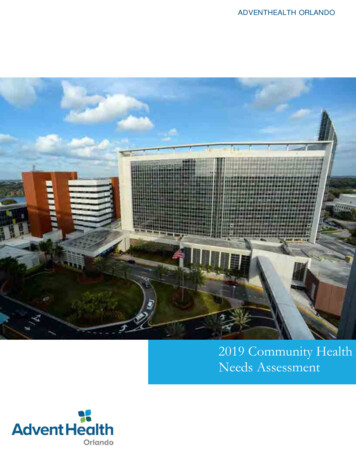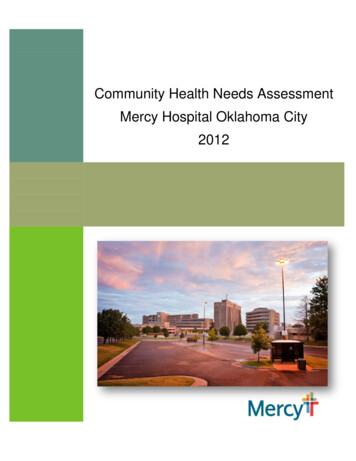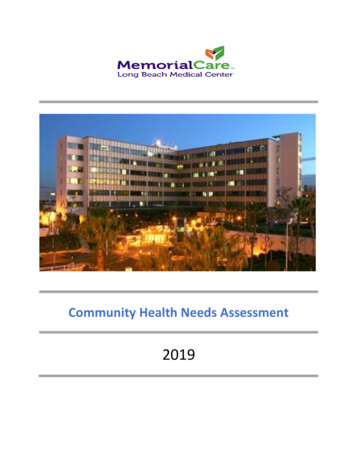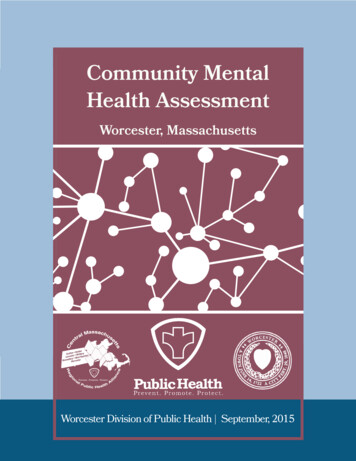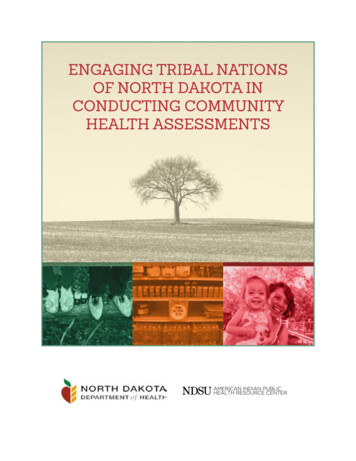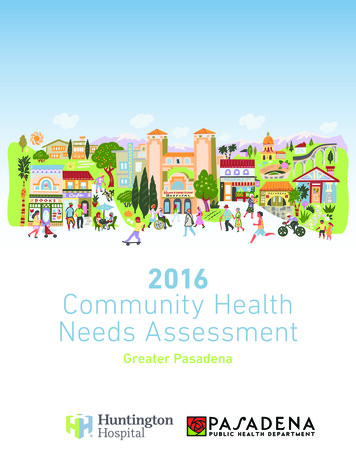
Transcription
2016Community HealthNeeds AssessmentGreater PasadenaPUBLIC HEALTH DEPARTMENT
2016 Community Health Needs Assessment of Greater Pasadenadecember 2016
Table of ContentsAcknowledgementsiExecutive SummaryivI. Introduction1II. Data Overview6III. Demographics8IV. Community Input11V. Social Determinants of HealthEconomy, Housing, and HomelessnessEducationSocial EnvironmentEnvironmentPublic SafetyTransportation16162224252830VI. Health TopicsAccess to CareMaternal, Child, and Adolescent HealthExercise, Nutrition, and WeightDiabetesHeart Disease and StrokeCancerImmunizations and Infectious DiseasesRespiratory DiseasesInjury Prevention and SafetyOther ConditionsOlder Adults and AgingMental HealthSubstance AbuseMortality333336394243444548505051535557VII. Prioritization58VIII. Conclusion61AppendicesAppendix A: Community Health Needs Assessment Progress ReportsAppendix B: Healthy Communities Institute Data Analysis MethodsAppendix C: Community Resources62628083References932016 Community Health Needs Assessment of Greater Pasadena
AcknowledgementsCHNA PLANNING TEAMHuntington Hospital: Cathi Chadwell, Executive Director, Public Affairs Lois Zagha, Manager, Community Outreach and Community BenefitsPasadena Public Health Department: S. Michael Johnson, MPA, Director Ying-Ying Goh, MD, MSHS, Health Officer Matt Feaster, MPH, EpidemiologistHUNTINGTON HOSPITAL COMMUNITY BENEFITS COMMITTEEMike Barilla, Chief, Emergency Services, Pasadena Fire DepartmentBill Bogaard, Member, Board of Directors, Huntington HospitalSheri Bonner, President and CEO, Planned Parenthood of Pasadena andSan Gabriel ValleyPeggy Buchanan, Executive Director, The Pasadena VillageCathi Chadwell, Executive Director, Public Affairs, Huntington HospitalVannia De La Cuba, City Council District 5 Liaison, City of PasadenaR-lene Mijares de Lang, Community AdvocateMary Donnelly-Crocker, Executive Director, Young and HealthyRita Elshout, Community AdvocatePriscilla Gamb, Community AdvocateAkila Gibbs, Executive Director, Pasadena Senior CenterYing-Ying Goh, MD, Health Officer, Pasadena Public Health DepartmentJane Haderlein, Senior Vice President, Philanthropy and External Affairs,Huntington HospitalDolores Hickambottom, Retired Field Representative, City of PasadenaBetty Ho, Community AdvocateS. Michael Johnson, Director, Pasadena Public Health DepartmentLena Kennedy, Community AdvocateMary Kirchen, Executive Director, Housing WorksHector La Farga, Executive Director, Mothers’ ClubDavid Lee, CEO, Huntington Health PhysiciansEllen Lee, Member, Board of Directors, Huntington HospitalLolita Lopez, Member, Board of Directors, Huntington HospitalSteve Madison, Councilmember, District 6, City of PasadenaMargaret Martinez, CEO, ChapCarei2016 Community Health Needs Assessment of Greater Pasadena
acknowledgementsLois Matthews, Member, Board of Directors, Huntington HospitalStacy Miller, Director, Volunteer and Customer Services, Huntington HospitalJeremy Mo, Employer Relations Specialist, Huntington HospitalKathy Podley, Member, Board of Directors, Huntington HospitalStephen A. Ralph, President and CEO, Huntington HospitalAnn Rector, Director, Health Programs and School Support Services,Pasadena Unified School DistrictSheryl Rudie, Executive Director, Ambulatory Services, Huntington HospitalCody Ruedaflores, Manager, Community Benefits Program, Kaiser PermanenteJuliana Serrano, Director, Office of Creative Connections, All Saints ChurchKimberly Shriner, MD, Huntington HospitalRosemary Simmons, Member, Board of Directors, Huntington HospitalRhonda Stone, City Council District Liaison, Office of Mayor Terry Tornek, City ofPasadenaTakako Suzuki, City Council District 6 Liaison, City of PasadenaWendy Wang, Director, Community Education, Outreach and Public Policy, Pacific ClinicsMark Waterson, Executive Director, Convalescent Aid SocietyDebbie Williams, Member, Board of Directors, Huntington HospitalLois Zagha, Manager, Community Outreach and Community Benefits, Huntington HospitalCOMMUNITY MEETING PARTICIPANTSSergio Bautista, CFO, ChapCareIoakim Boutakidis, Professor, California State University, FullertonPeggy Buchanan, Executive Director, The Pasadena VillageCathi Chadwell, Executive Director, Public Affairs, Huntington HospitalNicole Collins, Choose Health LA Program, Pasadena Public Health DepartmentLatrease Crockett, Community ResidentErika Davies, HIV Programs, Pasadena Public Health DepartmentBill Davis, Community Services Supervisor, Villa Parke Community Center,Pasadena Human Services & Recreation DepartmentMary Donnelly-Crocker, Executive Director, Young and HealthyJudith Dunaway, WIC Program Director, Pasadena Public Health DepartmentKathleen Eastwood, RN, Community Health Practitioner, Huntington HospitalRita Elshout, Community AdvocateNicole Evans, Black Infant Health, Pasadena Public Health DepartmentMatt Feaster, Epidemiologist, Pasadena Public Health DepartmentYing-Ying Goh, MD, Health Officer, Pasadena Public Health DepartmentJane Haderlein, Senior Vice President, Philanthropy and External Affairs,Huntington Hospital2016 Community Health Needs Assessment of Greater Pasadenaii
acknowledgementsSophia Herrera, Social Worker, Ambulatory Care Center, Huntington HospitalDolores Hickambottom, Retired Field Representative, City of PasadenaBetty Ho, Community AdvocateS. Michael Johnson, Director, Pasadena Public Health DepartmentKristin Karlyn, MD, Medical Director of Pasadena Urgent Care, Huntington Health PhysiciansEileen Koons, Director, Senior Care Network, Huntington HospitalAdrienne Kung, Public Health Emergency Manager, Pasadena Public Health DepartmentDavid Lee, CEO, Huntington Health PhysiciansTyswaya Marin, Pasadena Public Health DepartmentMargaret Martinez, CEO, ChapCareLois Matthews, Member, Board of Directors, Huntington HospitalDiane Mgrublian, Director, Social Services, Pasadena Senior CenterMarilyn Myers, Clinical Director, Foothill Family ServicesLaura Pancake, VP, Wellness, Recovery, Integrated Care and Training, Pacific ClinicsGeraldine Perry-Williams, PHN, Director, Maternal, Child, Adolescent Health,Pasadena Public Health DepartmentRuth Pichaj, RN, Community Health Practitioner, Huntington HospitalStephen A. Ralph, President and CEO, Huntington HospitalAnn Rector, Director, Health Programs and School Support Services,Pasadena Unified School DistrictChristine Reeder, Adult Services Librarian, Pasadena Public LibraryRudy Salinas, Program Director, Housing WorksJuliana Serrano, Director, Office of Creative Connections, All Saints ChurchRosemary Simmons, Member, Board of Directors, Huntington HospitalLaura Smith, Professor, California State University, FullertonNoreen Sullivan, City Council District 4 Liaison, City of PasadenaTakako Suzuki, City Council District 6 Liaison, City of PasadenaSalomon Torrescano, Clinic Administrator, John Wesley Community Health InstitutePatricia Valencia, Emergency Preparedness, Pasadena Public Health DepartmentJenny Van Slyke, RN, Pre-hospital Care Coordinator, Huntington HospitalMark Waterson, Executive Director, Convalescent Aid SocietyPatty Watson-Wood, RN, Clinical Supervisor, Senior Care Network, Huntington HospitalDebbie Williams, Member, Board of Directors, Huntington HospitalLois Zagha, Manager, Community Outreach and Community Benefits, Huntington Hospitaliii2016 Community Health Needs Assessment of Greater Pasadena
Executive SummaryHuntington Hospital and the City of Pasadena Public Health Department are pleased topresent the 2016 Community Health Needs Assessment of Greater Pasadena. The goalof this collaboration was to conduct a joint, systematic analysis of health indicators thatprovides insight into the health status and needs of residents in the Greater Pasadenaarea.For 120 years, Huntington Hospital (HH) has served the Greater San Gabriel Valleycommunity through health care services, medical research, professional education andtraining, provision of care for vulnerable populations, and support of programs that mayotherwise be absent from the community. Huntington Hospital takes its mission seriouslyand, along with its community partners, actively seeks opportunities to ensure access tocare for everyone.Since 1892, the City of Pasadena Public Health Department (PPHD) has been responsiblefor helping protect, maintain and improve the health of the Pasadena community. Thecity of Pasadena is one of only three cities in the state of California that maintains its ownindependent local health jurisdiction.Huntington Hospital has conducted a triennial Community Health Needs Assessment(CHNA) in accordance with California Senate Bill 697 since its implementation in 1994,requiring tax-exempt hospitals to document activities undertaken to address communityhealth needs. The Patient Protection and Affordable Care Act (ACA), enacted in 2010,included in IRS Section 501(r), directs tax-exempt hospitals to conduct a CommunityHealth Needs Assessment and develop an Implementation Strategy every three years.The CHNA serves as a tool for effectively planning the allocation of community benefits toimprove the health of the community.Since 1992, the PPHD has published several Quality of Life Index reports for thePasadena/Altadena region. Each report was a broad assessment of indicators related tosocial determinants of health. Both HH and PPHD leadership recognized the opportunityto partner as we work toward our shared goal of improved community health.OUR COMMUNITYThe 2016 Community Health Needs Assessment of Greater Pasadena focuseson the geographic area of Greater Pasadena, which includes Pasadena, Altadena,South Pasadena, and San Marino. The information gathered and contained in thisreport establishes the foundation for future planning to address the health needs ofGreater Pasadena residents. The findings of this assessment can assist the planningand improvement efforts of civic leaders, non-profit organizations, and communityconstituents.2016 Community Health Needs Assessment of Greater Pasadenaiv
executive summarySIGNIFICANT COMMUNITY NEEDSQuantitative and qualitative data were collected and analyzed for this CHNA. Quantitativedata refers to information that can be expressed in numerical terms, counted, measuredor compared on a scale. Qualitative data, on the other hand, refers to information thatis difficult to measure, count or express in numerical terms, but provides rich, indepth descriptive information about a field of interest. The synthesized data resultswere combined and arranged by topic. In the Huntington Hospital community benefitprioritization process, the following twelve areas of need emerged: Access to CareExercise, Nutrition, and WeightMental HealthEconomy/Affordable HousingSocial Environment/Cultural CompetencyTransportation Child and Adolescent Health Older Adults and Aging Heart Disease and Stroke Dental Health Public Safety Education EquityPRIORITIZATION PROCESSA group of health and social service professionals with specific clinical and communityknowledge participated in a review and discussion of the findings of the preliminary dataanalysis. In a facilitated prioritization session, participants rated each health topic areabased on criteria reflecting the hospital’s mission, values, strengths, and resources. Thesix highest rated areas of need were: Access to CareHeart Disease and StrokeChild and Adolescent HealthMental HealthOlder Adults and AgingExercise, Nutrition and WeightNEXT STEPSFindings from the 2016 Community Health Needs Assessment of Greater Pasadena willbe the foundation upon which the hospital’s Community Benefits Committee, ExecutiveManagement Team, and Board of Directors will develop meaningful community healthimprovement efforts.The City of Pasadena Public Health Department will be launching a separate communitywide effort to evaluate, prioritize and plan for health improvements based on thefindings from this 2016 Community Health Needs Assessment of Greater Pasadena.This broader Community Health Improvement Plan (CHIP) process will include thefull spectrum of community partners, in addition to Huntington Hospital, to create animprovement plan with a full range of community health issues.v2016 Community Health Needs Assessment of Greater Pasadena
I. IntroductionHuntington Hospital and the Pasadena Public Health Department (PPHD) are pleased topresent the first joint Community Health Needs Assessment (CHNA) report for GreaterPasadena. This report describes findings from a systematic, year-long CHNA processthat was conducted collaboratively in order to provide insight into the health status andneeds of the residents of the Greater Pasadena area. Data presented in this report spana wide range of topics related to community well-being, including disease rates, riskfactors for disease and death, health behaviors, and social determinants of health.The examination of key health indicators in the Greater Pasadena area offers someunderstanding of health needs in this community and will guide community healthimprovement planning efforts. This CHNA is intended to provide a gateway for concernedcommunity members, civic leaders, non-profit organizations, and policy makers tofurther delineate and address health issues in Greater Pasadena. This report andhealthypasadena.org are meant to be resources for health and health care advocates andorganizations that use the data to guide planning, policy development, and procurementor allocation of resources.Although genetics and individual behaviors contribute to health status, research showsthat other risk-factors, such as environmental, social, and economic conditions, are veryimportant in determining the health and well-being of individuals and populations. Bystudying these social determinants of health, health advocates can address “upstream”causes of diseases. In this CHNA, a variety of data were collected and compiled tocharacterize the health status of the population in Greater Pasadena. These data includedemographics, social determinants of health, and health metrics. Specific efforts weremade to identify and highlight health disparities for sub-populations, when the data wereavailable.2016 Community Health Needs Assessment of Greater Pasadena1
introductionAbout the Region of FocusFigure 1. Greater Pasadena and City of PasadenaWhile the geographic focus of this report is the Greater Pasadena area, the data comefrom a variety of sources with different catchment areas. This report aims to presentthe most granular level of analysis when possible, but in some instances data are onlyshown at the higher geographic level due to limitations in sample size or data availability.In this report, data are reported in one of three distinct geographic regions: 1) GreaterPasadena (Figure 1), 2) city of Pasadena (Figure 1), or 3) Service Planning Area (SPA)3–San Gabriel Valley (Figure 2).Figure 2. Los Angeles County and Service Planning Area (SPA) 3 - San Gabriel Valley22016 Community Health Needs Assessment of Greater Pasadena
introductionAbout the CHNA ProcessThe 2016 Community Health Needs Assessment of Greater Pasadena was developedutilizing a framework adapted from the Association for Community Health Improvement(ACHI) (Figure 3).1 There are six important steps in the process: 1) establishing theassessment infrastructure, 2) defining the purpose and scope of the assessment, 3)collecting and analyzing data, 4) selecting priorities and identifying related resources,5) documenting and communicating results, and 6) planning for action and monitoringprogress.Figure 3. 2016 Community Health NEEDS Assessment ProcessEstablishingthe AssessmentInfrastructure(Step 1)Planning for Action andMonitoring ProgressDefining thePurpose and Scope(Step 6)(Step 2)Six CoreProcess StepsDocumenting andCommunicating ResultsCollecting andAnalyzing Data(Step 5)(Step 3)Selecting Priorities andIdentifying Resources(Step 4)2016 Community Health Needs Assessment of Greater Pasadena3
introductionAbout the CHNA TeamHuntington HospitalHuntington Hospital is a 625-bed, not-for-profit community hospital located inPasadena, California. Founded in 1892, Huntington Hospital is committed to providingexcellent patient care delivered with compassion and respect. The hospital offers afull complement of acute medical care and community services, ranging from generalmedicine to the foremost specialized programs in cardiovascular, oncology, andneurosciences, is nationally recognized for Huntington Hospital Senior Care Network’sinnovation, quality care, and aging expertise, and operates the only Level II trauma centerin the San Gabriel Valley. Huntington offers state of the art orthopedic surgery, inpatientand outpatient psychiatric care, women’s and children’s services, and an ambulatorycare center. Huntington is a designated California Children’s Services Facility. Through apartnership between Huntington Hospital and Shriners Hospital for Children-SouthernCalifornia, inpatient surgical and medical services for pediatric patients are available.As a teaching facility affiliated with the University of Southern California Keck School ofMedicine, Huntington supported 26 internal medicine and 15 general surgery residentsin 2015. More than one-third of Huntington’s residents remain in the area to practice,providing a seamless transition through generations of care.In accordance with both state and federal legislation applying to non-profit, taxexempt hospitals and set forth by California Senate Bill 697 and the Patient Protectionand Affordable Care Act, Huntington Hospital conducts a triennial CHNA to analyzeand identify the health needs of the Greater Pasadena community, and develops animplementation strategy to meet the identified needs. Please see Appendix A: CommunityHealth Needs Assessment Progress Reports for an evaluation of progress since theprevious CHNA.Pasadena Public Health DepartmentSince 1892, the City of Pasadena Public Health Department has been responsible forhelping protect, maintain and improve the health of the Pasadena community. The cityof Pasadena is one of only three cities in the state of California that maintains its ownindependent local health jurisdiction.The PPHD is responsible for ensuring a healthy community through legally mandatedservices, essential public health functions, enforcement of the State Health and SafetyCode, and administration of other policies, statutes, regulations and programs. To meetthe needs of Pasadena’s diverse community, the PPHD tailors interventions, monitorshealth status, diagnoses and investigates health problems, empowers communitymembers, mobilizes community partnerships, enforces laws and regulations, works topromote access to health care, and continuously evaluates effectiveness in services.42016 Community Health Needs Assessment of Greater Pasadena
introductionThe City of Pasadena Public Health Department is dedicated to the physical, socialand mental well-being of all who live, work, learn and play in Pasadena. The PPHD iscommitted to building trusting relationships with the community; providing high-qualityservices; making health services accessible; achieving health equity; and creatingopportunities that foster health professional excellence.Healthy Communities InstituteHealthy Communities Institute (HCI), a Xerox Company, was retained by HuntingtonHospital to provide technical assistance for the 2016 Community Health NeedsAssessment of Greater Pasadena. HCI provides customizable, web-based informationsystems that offer a full range of tools and content to improve community health. HCIand Huntington Hospital have collaborated since 2010 and leveraged HCI technology todevelop the Healthy Pasadena platform (www.healthypasadena.org).To learn more, please visit www.HealthyCommunitiesInstitute.com.2016 Community Health Needs Assessment of Greater Pasadena5
II. Data OverviewABOUT THE DATAQuantitative and qualitative data were collected and analyzed for this Community HealthNeeds Assessment (CHNA). Quantitative data refers to information that can be expressedin numerical terms, counted, measured or compared on a scale. Qualitative data, onthe other hand, refers to information that is difficult to measure, count, or express innumerical terms, but provides rich, in-depth descriptive information about a field ofinterest.QUANTITATIVE DATAThe quantitative data collected and analyzed for this assessment comes from a varietyof sources, including public agencies like the United States Census Bureau and thePasadena Public Health Department.For certain social determinants of health or health topics, an Indicator Summary Tableis provided at the end of each section. Each table lists indicators that are tracked onhealthypasadena.org, a web-based community health data platform developed byHealthy Communities Institute, sponsored by Huntington Hospital, and contributed to bythe Pasadena Public Health Department. The indicators are derived from local primarydata sources and state and national public secondary data sources.Each indicator in the Summary Tables was assigned a comparison score from zeroto three and a corresponding color on a spectrum ranging from green, to yellow, tored, in order to show how the local community indicator value compared to selectedcomparison values. The comparison value for any indicator could be one of the following:a distribution of counties in California or the United States, the value for the state ofCalifornia, the value for the U.S., the trend of the indicator’s value over time, and/orthe value stated in national Healthy People 2020 goals. Healthy People 2020 goals arenational objectives for improving the health of the nation set by the U.S. Department ofHealth and Human Services’ Healthy People Initiative.For indicators highlighted in green with number scores approaching zero, the localindicator value was better than the comparison values. For indicators highlighted in redwith number scores approaching the maximum of three, the local indicator was worsethan the comparison values. Many indicators were assigned colors and number scoressomewhere between the extremes of the scale. These comparison scores were utilizedto consider which indicators might demonstrate more or less community health need.For additional details on each indicator, please reference healthypasadena.org.When sufficient demographic data was available (e.g., race, ethnicity, gender), analysesof sub-populations were conducted to look for disparities. Please see Appendix B: HealthyCommunities Institute Data Analysis Methods for more details on the quantitative datamethodology.62016 Community Health Needs Assessment of Greater Pasadena
Data overviewTABLE 1. SOCIAL DETERMINANTS OF HEALTH AND HEALTH TOPICS INVESTIGATED FOR GREATERPASADENA COMMUNITY, 2016SOCIAL DETERMINANTS ofHealthEconomy, Housing, andHomelessnessEducationSocial EnvironmentEnvironmentPublic SafetyTransportationHEALTH topicsAccess to CareRespiratory DiseasesMaternal, Child, and Adolescent HealthInjury Prevention and SafetyExercise, Nutrition, and WeightOther ConditionsDiabetesOlder Adults and AgingHeart Disease and StrokeMental HealthCancerSubstance AbuseImmunizations and Infectious DiseasesMortalityQUALITATIVE DATAThe Pasadena Public Health Department gathered qualitative data through key informantinterviews and a community stakeholder meeting. Ten in-person key informantinterviews were conducted with knowledgeable community members who providedfeedback on social and health topics. The community stakeholder meeting held atHuntington Hospital had forty-nine participants. Participants included representativesfrom health care organizations, mental health agencies, social service organizations,local government, the public school district, and other interested professionals andcommunity members familiar with the health needs of the Greater Pasadena community.The qualitative data are described further in section IV. Community Input and in therespective topic sections in the main assessment (Sections V and VI)DATA CONSIDERATIONSFor both quantitative and qualitative data, efforts were made to include as wide arange of data indicators as possible. Limitations on data availability varied by topic.Although the CHNA planning team selected a diverse, comprehensive representation ofstakeholders to minimize bias, qualitative data findings are inherently dependent uponboth the selection and participation of stakeholders. Quantitative data was limited bythe types of measures available at the time of analysis and the selection of measures.Analysis on disparities was possible for indicators with sufficient demographic data,such as those at a SPA or city level.2016 Community Health Needs Assessment of Greater Pasadena7
III. DemographicsPopulationThe geographic boundary of Greater Pasadena is the primary unit of analysis for thisassessment. Greater Pasadena is made up of the following nine ZIP codes: 91001,91030, 91101, 91103, 91104, 91105, 91106, 91107, and 91108. Figure 4 illustrates thegeographic boundaries of the Greater Pasadena service area and the city of Pasadenalimits (black outline in Figure 4), and Table 2 displays the population counts for each ZIPcode.Figure 4. greater pasadena population by zip code, 20162Table 2. Greater PasadenaPopulation, 20162Zip 437,0119100137,111The total population for Greater Pasadena is 236,423, which is approximately 2.3% ofthe entire population of Los Angeles County.2 The population of the city of Pasadena is142,250.3 The majority of Greater Pasadena residents live in ZIP codes 91001, 91104, and91107. Between 2010 and 2016, the population of Greater Pasadena grew by 3.7%, whichis slower than the population growth experienced by Los Angeles County (4.3%) and thestate of California (5.6%).282016 Community Health Needs Assessment of Greater Pasadena
DemographicsAge and genderThe proportion of residents below 18 years of age (19.9%) is lower in Greater Pasadenathan in Los Angeles County (22.8%).2 The proportion of residents ages 45-64 and 65 andolder is higher in Greater Pasadena than in Los Angeles County.In Pasadena, the proportion of males and females are 49.1% and 50.9%, respectively.Among adults 18 years and over, 51.7% are female while seniors age 65 and over are58.6% female.3FIGURE 5. POPULATION BY AGE, GREATER PASADENA AND LOS ANGELES COUNTY, 2016229.3%28.4%Percentage of Total 445–6465 Age (years)Greater PasadenaLos Angeles CountyRace, Ethnicity, and LanguageThe racial and ethnic diversity of Greater Pasadena differs from that in Los AngelesCounty, as shown in Table 3. In Greater Pasadena, 53.8% of the population identifies asWhite compared to 49.3% in Los Angeles County.2 The percentage of Asian residents is18.6% in Greater Pasadena, while approximately 14.3% of Los Angeles County residentsare Asian.2 A lower percentage of Pasadena residents identify as Some Other Race(11.6%) compared to the percentage in Los Angeles County (22.2%).In addition, Greater Pasadena has a lower percentage of residents who identify asHispanic, approximately 29.2% of the population, compared to the percentage in LosAngeles County (48.7%).22016 Community Health Needs Assessment of Greater Pasadena9
DemographicsTable 3. Population by Race/Ethnicity, Greater Pasadena and Los Angeles County, 20162Greater PasadenaLos Angeles CountyWhite53.8%49.3%Black/African American9.9%8.4%American Indian/Alaska Native0.6%0.7%Asian18.6%14.3%Some Other Race11.6%22.2%2 Races5.4%4.7%29.2%48.7%RaceEthnicityHispanicTable 4 shows the most common languages spoken at home by Greater Pasadenaresidents. The most common language spoken by Greater Pasadena residents is English(57.3% of the population).2 Compared to Los Angeles County and California, a largerpercentage of Greater Pasadena residents speak Asian and Indo-European languages(such as Armenian) at home.Table 4. Language Spoken at Home, Greater Pasadena, Los Angeles County, and California,20163GreaterPasadenaLos AngelesCountyCaliforniaStateSpeak Only English at Home57.3%43.2%56.1%Speak Spanish at Home22.8%39.5%28.8%Speak Asian/Pacific Islander Languages at Home12.5%10.8%9.6%Speak Indo-European Languages at Home6.4%5.4%4.4%Speak Other Languages at Home0.9%1.1%1.0%In the city of Pasadena, the top five languages spoken at home other than English were:Spanish (27%), Chinese (Mandarin) (4.2%), Armenian (3.3%), Tagalog (1.9%), and Korean(1.2%).3102016 Community Health Needs Assessment of Greater Pasadena
IV. Community InputCommunity feedback (primary qualitative data) was collected as an important componentof the needs assessment. First, ten semi-structured key informant interviews wereconducted in order to identify and confirm significant community health issues. The datafrom these interviews with community stakeholders helped to ensure that quantitativedata were collected, when available, in those issue areas. The findings from theinterviews were also used to identify other knowledgeable community members toparticipate in interviews and provide feedback on the design of the health assessment.The second method for obtaining community feedback was to conduct a large communitystakeholder meeting. At the meeting, the preliminary data analysis was presented bythe CHNA planning team, and stakeholders provided input on gaps in data, quality ofdata, additional sources of data in the community, and the community health needsassessment process.Key Informant InterviewsTop Health NeedsFigure 6 below illustrates the top health needs for the Greater Pasadena community thatwere identified by key informants.Figure 6. Top Health Needs Identified by Key InformantsDental Caren 3Mental Healthn 6Healthy Foodsn 4Access to Caren 4Affordable Housingn 52016 Community Health Needs Assessment of Greater Pasadena11
Commun
ruth Pichaj, rn, Community Health Practitioner, Huntington Hospital stephen a. ralph, President and Ceo, Huntington Hospital ann rector, director, Health Programs and school support services, Pasadena unified school district Christine reeder, adult services librarian, Pasadena Public library rudy salinas, Program director, Housing Works
